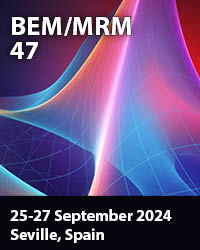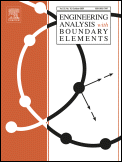33rd International Conference on Boundary Elements and Other Mesh Reduction Methods
28 - 30 June 2011
New Forest, UK
Overview and Opening Address
The 33rd International Boundary Elements and other Mesh-Reduction Methods Conference (BEM 33) has recently taken place at Ashurst Lodge, the campus of the Wessex Institute of Technology, located in the New Forest National Park, England.
The meeting was Chaired by Professor Carlos A Brebbia and Viktor Popov, both of the Wessex Institute.
Professor Carlos Brebbia opened the meeting by thanking the participants for having come to the conference. Many of them are well-known BEM researchers while others are younger people starting out in their academic or research careers, the latter being witness to the strength of the method.
Professor Brebbia opened the conference explaining the work of the Institute and the importance of the BEM conference. His introduction published in the conference book was as follows;
“Having been instrumental in originating the Method through the combined efforts of my associates at Southampton University, I do not cease to be surprised by its vitality. Since 1978 when the first conference took place and the first book bearing the BEM name was published, the method has constantly evolved.
“It is most unusual for a scientific conference dealing with a particular methodology to survive for as long as this conference has. I attribute this capacity to the wider remit of this Meeting, i.e. finding ways of reducing, or even better, totally suppressing the need for a mesh.
“In the 1970s our research group at Southampton University started to question the need to discretise the problem in order to find a numerical solution. It was the right question at the wrong time, as finite element was emerging as the dominant computational technique. This was the moment when our research on Boundary Elements started. It is difficult nowadays to envisage the hostile reception that BEM received at that time. It took another 10 to 15 years to demonstrate its advantages and by then we were already looking at ways of BEM evolving beyond its classical formulation.
“This led to the development of meshless techniques – research which has continued until today. A substantial part of the current work however seems to concentrate on finding simple solutions which may not always lead to the best results.
“It seems appropriate to put more emphasis on achieving robustness and accuracy in particular when solving large engineering problems. We need to develop general purpose computer codes equivalent to those produced with finite elements.
“This requires progression from the realm of mathematical possibilities into that of engineering certainty.
“The BEM/MRM conference is the ideal forum to discuss these and other issues which are crucial to the development of the Method. Since 1978, this series of conferences have produced more than 60 volumes recording all major advances in BEM/MRM.
“Judging by the papers presented at the conference, the topic continues to evolve, validating the need to hold these meetings on a regular basis. The next conference, due to take place in Split, Croatia from 25–27 June 2012, will ensure that.
Professor Brebbia ended his remarks by expressing his sincere gratitude to all contributors for the quality of the papers and in particular to the members of the International Scientific Advisory Committee and other colleagues who helped to select them.
Invited Presentations
The conference was enhanced by a series of outstanding invited presentations given by renown BEM researchers, i.e.;
‘Probabilistic fatigue crack growth using BEM and reliability algorithms’
by E. D. Leonel, University of Sao Paulo at Sao Carlos, Brazil
‘Modification of Gauss-Chebyshev quadrature for modelling of crack growth in the field of residual stresses’
by A. N. Galybin, Russian Academy of Sciences, Russia
‘A tangential differential operator applied to stress and traction boundary integral equations for plate bending including the shear deformation effect’
by L. Palermo Jr., University of Campinas, Brazil
‘The BEM for buckling analysis of viscoelastic plates modelled with fractional derivatives’
by J. T. Katsikadelis, National University of Athens, Greece
‘Moment formulation for random eigenvalue problems in beams’
by B. W. Yeigh, SUNY Institute of Technology, USA
‘Dynamic simulation of heat conduction using a BEM model in the frequency domain - an experimental validation’
by I. Simoes, University of Coimbra, Portugal
‘A shape sensitivity analysis approach based on the boundary element method’
by T. Matsumoto, Nagoya University, Japan
‘An efficient boundary element modeling of the time domain integral equations for thin wires radiating in a presence of a lossy media’
by D. Poljak, University of Split, Croatia
‘BEM simulation of transient fluid flow phenomena’
by L. Škerget, University of Maribor, Slovenia
‘Time integrations in solution of diffusion problems by local integral equations and moving least squares approximation’
by V. Sladek, Slovak Academy of Sciences, Slovakia
‘The MFS for the detection of inner boundaries in linear elasticity’
by A. Karageorghis, University of Cyprus, Cyprus
‘IRBFN-based multiscale solution of a model 1D elliptic equation’
by T. Tran-Cong, University of Southern Queensland, Australia
‘Accurate gradient boundary conditions using radial basis functions’
by E. J. Kansa, University of California at Davis, USA
‘URANS and LES methodology for two-dimensional natural convection in a differentially heated cavity by BEM’
by J. Ravnik, University of Maribor, Slovenia
‘Recent advances on singular boundary method’
by W. Chen, Hohai University, China
‘A meshless method solution approach for the transient poro-elastic levee problem’
A. Kassab, University of Central Florida, USA
Conference Sessions
The conference sessions covered a wide variety of topics which were grouped under the following headings;
- Advances in solid mechanics
- Computational mechanics
- Fluid flow applications
- Advanced formulations
- Advanced meshless and mesh-reduction methods
The meeting was characterised by its friendliness and the many discussions that took place in an informal environment as well as within the conference sessions. There were plenty of social occasions for the delegates to strengthen their links.
A lamb barbeque took place during the lunch break on the first day of the conference. Hampshire lamb is renown for its quality and this added to the enjoyable surroundings and benign weather.
Editorial Board Meeting of the International Journal of Engineering Analysis with Boundary Elements
A meeting of the Editorial Board of the International Journal of Engineering Analysis with Boundary Elements took place during the conference. The meeting, which took place over dinner, attracted a substantial number of members and was attended by a representative from Elsevier who spoke about the achievements and strengths of the Journal, particularly the considerable increase in the Impact Factor that has taken place in the last few years. Professor Brebbia then discussed the scope of the Journal and several recommendations were made aiming to cover new fields of application of BEM/MRM. Next, he presented a list of new nominations for membership of the Journal’s Editorial Board which were approved by the Board. Professor Brebbia explained how important it is continue renewing the Board in an effort to retain the Journal’s capability to attract outstanding papers on topics of current relevance. Because of this, Professor Brebbia has decided to take the position of Honorary Editor and has arranged with Elsevier for his Co-Editor, Alex Cheng from the University of Mississippi at Oxford, to be appointed as Editor-in-Chief. Professor Brebbia felt confident that the Journal will be able to continue prospering under Alex’s direction. Professor Brebbia, as Founder of EABE, has acted as its Editor-in-Chief since 1984, and he has steered the publication throughout its formative years and a period of growth consolidation. Now EABE is in a very strong position, attracting a large quantity of high-quality papers. It seems this is the appropriate moment to leave the Journal in the hands of Alex Cheng.
At the end of the meeting, Elsevier’s representative, Dan Lovegrove, presented Professor Brebbia with a crystal decanter, suitably engraved for the occasion, to commemorate his long service to the Journal.
Social Events and Visits
The conference included other social events, amongst them a lunchtime visit to the town of Lymington. The excellent weather contributed to the enjoyment of the visit. Lymington was one of the trading posts of the New Forest, and now mainly known as a marina. The most beautiful part of Lymington is its wide High Street and the numerous Georgian houses on either side. At the bottom of the high street is a lane descending to the front of Quay Hall, with beautiful cottages, many of which are now restaurants and shops.
The town originated in a Royal Land Grant given to its founder in the XIIth Century. Lymington in due course became famous for its market and the trading related to its port. It was also a centre for the manufacturing of salt. Seawater was converted into brine in shallow pools called ‘salterns’ and the brine was then boiled inside large barns to produce salt. The industry lasted until the 19th century, when it collapsed due to the discovery of salt mines.
The delegates had occasion of walking around the town and enjoying the shops and the good weather before returning to the Institute for the afternoon sessions.
Most delegates were staying in Lyndhurst, the town nearest to the Institute campus which contains many hotels and interesting shops. It is also where the New Forest Museum is located. The Museum contains excellent displays describing the history of the Forest as well as its many attractions. It is worth a visit.
Lyndhurst is also famous for its Church which towers over the town. It is the Parish Church of St Michael and All Angels and contains frescos by Lord Leighton and stained-glass windows by Edward Burne-Jones. The burial grounds contain the grave of Alice Hargreaves who as a girl inspired the mathematician, Professor Charles Dodgson, of Christ Church College, Oxford, better known as Lewis Carroll, to write Alice in Wonderland.
The next conference is to take place in Split, Croatia, from the 25th to the 27th June 2012. For further information see http://www.wessex.ac.uk/12-conferences/bem-mrm-2012.html
Publication of Papers
The proceedings of Boundary Elements and Other Mesh-Reduction Methods XXXIII, 368pp (Print ISBN: 978-1-84564-542-7; Online ISSN: 1746-4064) are available in paper and digital format from WIT Press priced at £158/US$316/€221. Orders can be placed on the WIT Press web site at www.witpress.com or by email:
Papers from the conference will also be hosted online at the WIT eLibrary as Volume 52 of WIT Transactions on Modelling and Simulation (Online ISSN: 1746-4064). For more details visit the WIT eLibrary at http://library.witpress.com




